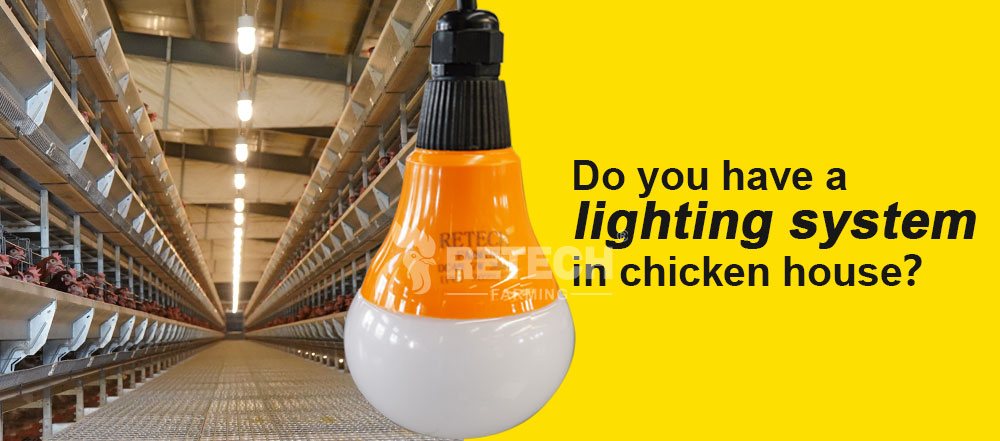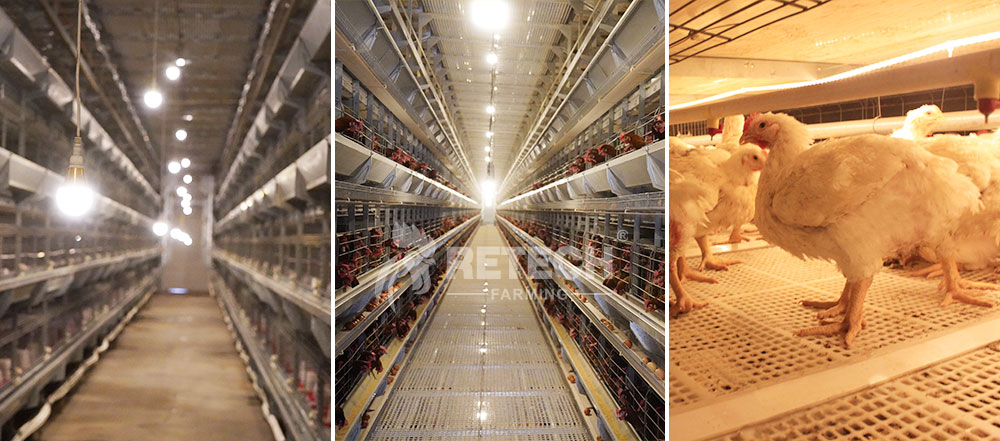Close search
 Published :
/
Published :
/ Posted by : Retch
Posted by : RetchLighting in poultry houses is an important factor in the success of the commercial production of layers and broilers. Proper lighting can help to ensure that the birds are healthy, productive, and safe. The intensity and duration of light exposure can affect the growth rate, feed conversion efficiency, egg production, and other physiological processes. It also helps to create a comfortable environment for the birds, which can lead to better egg production and improved meat quality. Additionally, lighting control systems can be used to simulate natural daylight cycles, providing a more natural environment for the birds. This helps to reduce stress levels in the chickens and improve overall health and productivity.

So what are the advantages of lighting systems for poultry houses? Here are the few points that might help you understand the importance of poultry house lighting systems for poultry production:
Lighting systems can be used to regulate the growth rate of birds, which is important for both layers and broilers. By providing a consistent light cycle, birds are able to grow at a more consistent rate, leading to better feed conversion efficiency and higher yields.
Lighting systems can also be used to improve the quality of chicken meat produced by broilers. By providing a consistent light cycle, birds are able to grow at a more consistent rate, leading to better feed conversion efficiency and higher yields.
by providing a comfortable environment with proper lighting intensity and duration.
In order to control the lighting, we have to know how to measure the lighting first, total light source output is measured in “lumens” (lumens per area is equal to foot candles or lux). Lumen is defined as the rate at which light falls on a square foot area surface which is equally distant one foot from a source whose intensity is one candela. Foot-candle is another term used to measure illumination on a surface and is defined as the intensity of light striking each and every point on a segment of the inside surface of an imaginary one-foot radius sphere with a one candlepower source at the center. The efficiency of a light source is measured in lumens per watt. Typical light levels found in broiler and layer operations are about 10 to 20 lux (1 to 2 foot candles), in comparison Typical light levels on the surface of an office desk might be 400 to 500 lux (40 to 50 foot candles).
In some tropical regions like Africa or South Asia, where extreme weather conditions can be detrimental to poultry production, chicken farm lighting systems can be used to create a more stable environment for birds. By providing a consistent light cycle and intensity, the birds are less likely to experience heat stress or other adverse effects of temperature fluctuations. In addition, lighting systems can be used to extend the photoperiod in order to increase egg production. By controlling the length of day and night, producers can manipulate reproductive cycles and optimize egg production. For example, in some countries, producers use long days (up to 18 hours) during the summer months to increase egg production.
According to recent research from some egg-laying hens farms in Africa, the length and intensity of light received by birds daily is an important factor in determining their egg production. Generally, longer days with more intense light result in higher egg production rates. To ensure optimal egg production, poultry producers must provide their birds with at least 14 hours of light per day. Additionally, they should use lighting systems that can be adjusted according to seasonal changes in day length and intensity. By doing so, they can ensure that their birds are receiving enough light to achieve optimal egg production.

The lighting system is not just used for egg-laying hens only to improve egg production, can also be used to improve the productivity of broiler farms. By conducting the experiment at some broiler farms in South Asia, Research shows that by providing a more natural light cycle, producers can reduce stress levels and improve bird behavior. the lighting systems can be used to stimulate feed intake and increase the growth rates of broilers and improve production performance.
The intensity of the light should also be adjusted according to the age of the birds, Light intensity is an important factor in the successful rearing of the whole life cycle of chickens,, for example,
For brooding period,which is the first 6 weeks of a chick's life, is an incredibly important time for their development. During this period, chicks need to be exposed to adequate amounts of light in order to feed, drink, exercise and stay healthy. If the illumination time is too long, it can lead to sexual precocity which can have a negative effect on their laying performance in the future. On the other hand, if the illumination time is too short it can affect their activity levels and feed intake leading to growth retardation.
For younger pullet periods,need less intense lighting than older ones., processors and breeding companies require a light intensity of at least 20 lux to ensure that chicks are able to find food and water easily. This higher level of light also helps to keep chicks warm and comfortable during this critical period.
Once the chicks grow older and have almost grown into full-sized birds, the light intensity should be lowered to between 5 and 8 lux. This lower level of light helps to reduce stress levels in the flock, which can lead to improved health and productivity. It also helps to prevent cannibalism among birds, as they are less likely to see each other as potential prey when there is less light available.
It is important to provide a consistent level of light throughout the day as this will help keep the birds active and alert. In addition to providing adequate lighting, it is also important to ensure that there are no dark areas in the poultry house as this can lead to stress and aggression among birds.

In conclusion, poultry producers must ensure that their birds are receiving the right amount of light in order to achieve optimal egg production and growth rates. The intensity and duration of the light should be adjusted according to the age of the birds and season changes.
Retech has been exploring and studying the poultry industry for over 30 years, we’re very familiar with your local market, helped many chicken farmers to achieve great success by renovating their farms and upgrading their equipment, with more than 30 years of production experience, we can design and manufacture both chicken house and chicken cage based on your need and requirement, we can provide clients with automatic layer cage, broiler cage, and pullet cage, with best quality raw material, state of art of technology, competitive price, good service before/after the sale.
So if you looking for a Poultry chicken business opportunity, and if you want to start your own Poultry Chicken Business, pls feel free to give us a call, would be more than happy to help you!
Website: www.retechfarming.com
Facebook: @retechfarmingchickencage 100k Followers
Ins:www.instagram.com/retechfarmingchickencage/
Whatsapp: +8618561818859
Email: info@retechfarming.com